| |
Chinese Independent Cinema : origins, development and
present challenges
Le
cinéma indépendant chinois : origines, développement et
défis actuels
par Brigitte Duzan
|
“Chinese independent cinema” is an expression which
has been coined by the very directors most commonly
associated with the movement. It appears in the
title of a book which has marked their strongest
assertion of existence as a community, namely a
collection of interviews with ten directors
published in 2007 under the title “On the Edge :
Chinese Independent Cinema” (《中国独立电影:访谈录》)
(1).
By that
time, it was generally accepted as a common
reference for those filmmakers and applied to a
movement which had evolved from a chaotic
underground movement to a more disciplined one,
trying to negotiate with the authorities for a
recognized position within Chinese cinema. But it
had begun some eighteen years before.
It all
started in the aftermath of the Tian’anmen events of
June 1989, in a period of repression, of drastic
curtailment of |
|

On the Edge : Chinese
Independent Cinema |
the relative
freedom that had blossomed in the few years before. It
resulted in a breach in the monopolistic state system, but
it was not so much a conscious move towards artistic
freedom, still less a gesture of defiance ; it was rather a
personal initiative driven by circumstances. It then
developed because technical progress made it possible to
shoot a film on a shoe-string budget, without the need to
depend on a studio.
This is the
first signification of what is meant by Chinese independent
cinema : mainly underground filmmaking, breaking loose from
the state-sanction production system. Thence the first
questions which come to anybody’s mind : How did this
happen, and why ? And as in a criminal movie : who did it ?
Then how did it become a full-fledged independent movement ?
But a further
reflection inevitably leads to question the very concept of
independence : it does not exist in the absolute, but is
always defined as an absence of dependence on something or
somebody. The next step therefore leads to ask : can we
really speak of independent cinema ? Has it ever been
independent ? Is it a significant concept today ? And if
so, in which respect ?
I.
Independence : origins and development
Chinese
independent cinema developed at the same time in both
documentary and fiction, and actually blurred the two
concepts : independent cinema is also a stylistic story. The
chronology usually starts with one specific fiction film and
filmmaker, but we have to add the documentary counterpart to
have the whole picture, especially since the cross-breeding
happened from the very start.
1. Fiction
films : Zhang Yuan
|
Zhang
Yuan (张元),
who graduated from the Beijing Film Academy in June
1989, is generally credited with the first
independent film of the post-Tian’anmen period :
« Mama ». This is not exactly so, but it did signal
a movement to cut lose from the State studio system
to shoot films that could not otherwise have been
made. It is interesting to underline that Zhang
Yuan’s decision to shoot outside a studio was a
circumstantial move, and had originally no definite
pre-intention, just the desire to finish a film…
a)
« Mama »
« Mama »
(《妈妈》)
started as a project of the Children’s Film Studio ;
Zhang Yuan was still a student at the Beijing Film
Academy, but was supposed to be the film’s
cinematographer, his major at the Academy. The
script was called « The Sun Tree » (《太阳树》).
Zhang Yuan worked on |
|

Zhang Yuan |
the storyboard
with the scriptwriter Qin Yan (秦燕),
who was also to be the lead actor in the film. But, three
months later, the studio decided to cancel the whole project
which was not deemed profitable enough.
|
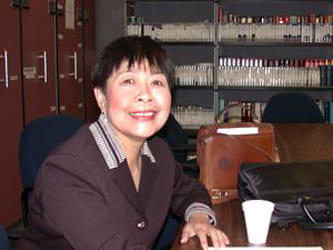
Dai Qing |
|
It was
then taken over by the August First Studio, this
time with another director, but Zhang Yuan again as
cinematographer. He was even sent scouting for
locations as far as Dunhuang. But the project was
again cancelled, after the Tian’anmen Square events,
mainly because the script was based on a short story
by Dai Qing (戴晴).
Originally an engineer working on guided missile
systems for the PLA, Dai Qing became an army writer,
then, in 1982, a columnist for the
|
Guangming Daily
(光明日报) ;
in 1989, she openly opposed the Three Gorges Dam Project,
and collected material on the subject which was later
published in a book. At the time of the Tian’anmen Square
protests,
Dai Qing joined other scholars, calling on the government to
curtail corruption and support democratic reform. When
students staged large protests that included a hunger
strike, Dai Qing made a passionate speech on Tian’anmen
Square, encouraging students to leave peacefully to avoid
bloodshed. She was one of those who warned the students
that, if they stayed, they could provoke a violent crackdown
that could seriously set back the process of reform. She was
not heeded, and the crackdown came on June 4. Dai Qing was
arrested on June 14, and stayed in prison until January
1990, but was still kept under surveillance until May.
|
Under
those circumstances, the film project was
understandably shelved. But Zhang Yuan had already
worked so much on it, he did not want to give it up.
The film focuses on a librarian struggling to raise
her mentally handicapped son in Beijing while, at
the same time, dealing with an absent and
unresponsive husband.
Zhang
Yuan had developed a deep and emotional
understanding of the subject, and had even
interviewed several mothers of handicapped children,
interviews which he later integrated
|
|

Dongdong and his
mother, in Mama |
into his film,
increasing its feeling of gritty reality.
He therefore
decided to go ahead, and revised the script with his wife,
the scriptwriter Ning Dai (宁岱),
and with
Wang Xiaoshuai (王小帅).
He shot the film in his apartment, mostly in black and
white, on a shoe-string budget of 100 000 yuans, financed
with funds collected from his family and his friends, plus
grants he had collected from small enterprises, touring the
country with a letter of recommendation of the National
Association of Handicapped Children.
In China,
the film
was deemed much too dark, and was banned as soon as it went
public, in 1990 ; on the contrary, it was feted abroad in
various film festivals and even won the Special Jury Prize
at the Nantes Three Continents Film Festival in 1991. On
that occasion, the president of the Jury referred to Zhang
Yuan as “the first Chinese independent director and
producer”, to the astonishment of Zhang Yuan who had had no
idea of the sort.
In fact, it was
not even exactly true.
« Mama »
had been formerly
declared and registered, under a licence number of the Xi’an
studio. Those license numbers were necessary to get approval
to buy film rolls. Four copies were then made of the film,
one was bought by Shenzhen local governement, two others by
the provincial administrations of Hubei and Jiangsu, and
the last one by the city of Shanghai which, at the time, had
the only arthouse cinema in China. Strictly speaking, it was
therefore not really independent.
b) « Beijing
bastards »
|
This
was not the case of Zhang Yuan’s second film : “Beijing
Bastards” (《北京杂种》),
in 1993. From the very start, the film’s credits
show no sign of either licence number or film
studio : this very silence proclaims it is « hors
système ».
A bleak
picture of youth, played by rock musicians and
artists, blending reality and fiction,
it is an allegory of the situation in China after
Tian’anmen, meaning that the young Chinese
considered themselves as bastards of the regime. It
is a veiled denunciation of the repression which
followed June 4th, since the famous rock
musician Cui Jian (崔健),
who plays the main part, had his music played in the
square during the students’ protests, rock music at
the time being a sign and symbol of rebellion.
Zhang
Yuan has emphasized that the film also has its
message of hope : at the end, the crying new-born
baby is |
|

Beijing Bastards |
supposed to
symbolize the future renaissance of Beijing and its youth.
But it remains, on the whole, a grim, desolate and desperate
movie that no studio would have produced.
|
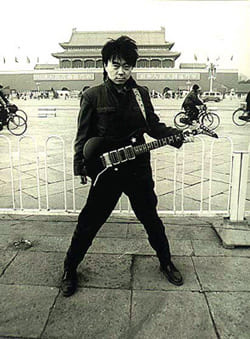
Cui Jian, symbol of
rebellion
beginning 1990’s |
|
It
could in fact be made thanks to a grant of the
Hubert Bals Fund of the Rotterdam Festival, and was
produced by three of the film’s main figures : Cui
Jian who plays the main part, but also wrote the
music and part of the script, Christopher Doyle who
was the cinematographer, and Hong Kong filmmaker Shu
Kei whom Zhang Yuan had met at the Nantes film
festival. However, for lack of money, postproduction
was suspended in 1992, and could be finished only
thanks to the help of the French ministry of
Culture.
So,
from this very start, independence was already quite
relative, since it entailed a dependence on foreign
sources of financing, technical backing and
promotion. This made the situation at home quite
difficult, turning into a kind of game of cat and
mouse.
What
made matters worse, was that Zhang Yuan “dared”
|
show his film
at the Locarno Film Festival, in spite of the Film Bureau
contrary advice ; they even threatened Marco Müller who was
at the time the director of the festival. The announcement
of the special mention garnered by “Beiing Bastards” was the
last straw. Zhang Yuan was officially condemned as
“spiritual polluter” and blacklisted.
The move was
rather drastic. Not only could he no longer make films in
China, other artists were also forbidden to work with him –
the ban extended to six other filmmakers ; studios were
forbidden to let them rent cameras or other equipment. At
the same time, the authorities promoted commercial and
‘harmless’ films, blockbusters (大片)
and New Year’s entertainment (贺岁片).
This further marginalized the young independent
filmmakers, but did not stop them. 1994-1996 is one of the
best periods for independent films.
Zhang Yuan went
on filming… but a documentary first : documentaries did not
have to be submitted to the censorship bureau, they enjoyed
relatively more freedom ; furthermore, it was adapted to the
very subjects the new filmmakers wanted to film, and indeed
it developed quickly in those years.
2.
Documentaries : Wu Wenguang
Here, again,
the general consensus is to point to a specific filmmaker
and film to mark the beginning of what has been called the
New Documentary movement. But the story does not
really start so abruptly. First, what appears as a sudden
shift of focus in subject and style comes from the preceding
period, from the “cultural fever” of the late 1980’s, and
the gradual consciousness that society was changing and
that, in the process, many people were left aside, on the
margins, and had to be accounted for, an awareness which
came along mainly because filmmakers identified with them.
But there was
no way for a filmmaker, still less than anybody else, to
express a personal view of what was happening, of what they
felt was happening. Documentaries in China since 1949 have
been a monopoly, in the hands of a central agency called the
Central Newsreel and Documentary Film Studio
(中央新闻记录电影制片厂),
created on the 7th of July 1953 as an agency
depending from the Party, as were the Xinhua Agency and
People’s daily. Documentaries had the sole purpose of
explaining history and serving official propaganda. They
were educational tools.
But they have
in fact a much longer history which needs to be quickly
recalled, to show that, when the new documentary movement
started at the turn of the 1980’s, it did not come entirely
out of the blue.
a) A long
history made short
|
The
Central Newsreel and Documentary Film Studio had its
origins in the Yan’an Film Group
(延安电影团),
founded
in 1938 under the leadership of the 8th
Route Army political department. But the first
documentary, called “Yan’an and the 8th
Route Army” (《延安与八路军》),
was
made by
Yuan Muzhi
(袁牧之),
who had just finished “Street Angels” (《马路天使》)
the year before. It was made in heroic conditions,
with a camera left by Joris Ivens, another one
bought in Hong Kong, and hardly enough film ;
post-production was made in Moscow in 1940, at the
outset of the war with Germany, so that the film was
lost.
But the
point, here, is that Yuan Muzhi himself was the
inheritor in the 1930’s of a documentary tradition
which can boast two leading forerunners : Sun
Mingjing and |
|
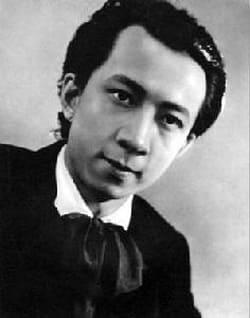
Yuan Muzhi |
Cheng Bugao. If
Sun Mingjing
(孙明经)
became part of the establishment after 1949, at the end of
the 1930’s he made a series of documentaries which can be
considered as independent : his series about the old
Tea-Horse Road, about the Ya’an salt-mines and about people
and sceneries in Xikang. But his purpose was mainly
educational.
|

Cheng Bugao |
|
This
was not the case of
Cheng Bugao
(程步高),
and he can truly be considered as a forerunner of an
independent documentary movement. He started his
career making documentaries in a small studio, the
Dalu studio (大陆影片公司),
which he created in the early 1920’s for the purpose
of showing what he was able to do and getting his
name known in order to gain entry into one of the
big studios of Shanghai. That is how and why he made
two documentaries : “Wu Peifu” (《吴佩孚》),
a portrait of a fascinating but ruthless commander
of the Zhili Clique, and “Luoyang Scenery”
(《洛阳风景》),
a forerunner of the Chinese “scenery films”.
Later
on, as he was working in the Mingxing studio, he
resumed shooting documentaries, at least on two
specific occasions : one in 1932, when the Japanese
launched their first assault on Shanghai, he went to
shoot “ The Battle of Shanghai” (《上海之战》).
But much more interesting is the |
film he made
one year later, the same year as his more famous « Spring
Silkworms » (《春蚕》).
The film is called “Wild Torrent” (《狂流》)
and was made on the basis of a documentary, but mixing
reality and fiction.
|
It all
started with a natural disaster in May 1931 : the
Yangzi flooded sixteen provinces. Cheng Bugao went
to film the disaster area around Wuhan with two
cameramen, and came back with a documentary showing
a shocking contrast between the poor victims
fighting to survive and the rich contemplating the
scene from afar. Back in Shanghai, he showed the
rushes to his friend Xia Yan (夏衍),
one of the leading scriptwriters of the Mingxing
film company with whom he was working on the script
of “Spring Silkworms” ; under the spell of these
images, Xia Yan imagined a story taking place in
that context, and focusing on the social conflict
between victims left fighting for themselves and
rich families going on with their life of leisure.
Cheng
Bugao then made the film, mixing footage from his
documentary with scenes of fiction, so that the
difference |
|
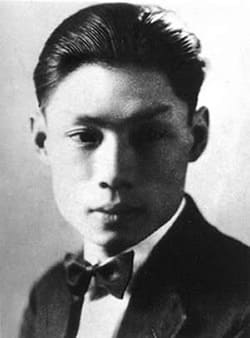
Xia Yan |
was blurred,
the main part being played by Hu Die (胡蝶).
The film had such an impact on the audience at its first
public screening, on the 5th of March 1933, that
it resulted in an immediate reaction of the Nationalist
government : studios suspected of leftist tendencies were
ransacked by squads of “Blue Shirts” and their films
blacklisted. It is generally considered as the true
beginning of left-wing cinema.
In this
respect, it must be underlined that the spirit that presided
over the emergence of this cinema as well as its later
development bears many similarities with the situation at
the beginning of Chinese independent cinema in the 1990’s.
When one considers the cinema produced in Shanghai in the
early 1930’s, the similarities are confounding. It has also
be noted by Zhang Zhen in her introduction to her book “The
Urban Generation” * :
“In modern
Chinese history, the 1930’s and 1990’s stand out as
strikingly parallel in terms of accelerated modernization
and urban transformation, aggressive industrial and
post-industrial capitalism, and an explosion of mass culture
with the accompanying issues of social fragmentation and
dislocation.”
A few lines
later, she adds this revealing comment :
“When asked
about the influence on him of the cinema of the 1930’s,
Zhang Yuan characterized it as “the most stylish and moving”
and “the most lively period” in Chinese film history.”
But chance was
the determining factor, like a spark igniting a pyre.
b) The New
Documentary movement of the 1990’s
It is not pure
coincidence that, in October 1993, the Central Newsreel and
Documentary Film Studio was formally placed under the
authority of CCTV. In fact, it was allotted such a
ridiculously small budget that it mainly subsists as manager
of the vast stock of documentaries it owns, which are
nowadays used by filmmakers shooting films on Chinese
history, and particularly the war. Official documentaries
are now made by and for television programs.
|
But, at
the same time, a new documentary movement emerged,
quite reminiscent of the 1930’s and in line with the
social preoccupations of the time, centred on the
lower and marginal classes of society, those bottom
(底层)
margins of the chaotic urban environment which the
fiction filmmakers were also focusing on.
It is
generally considered that the movement started in
the winter of 1991-92 : a big conference on
documentary filmmaking took place in Beijing at that
time, and was the opportunity to screen a number of
new works, mainly for television, but among the
films screened was the one by
Wu Wenguang (吴文光)
called “Bumming in Beijing : the last dreamers” (《流浪北京 :
最后的梦想者》),
which had also been screened at the 1991 Vancouver
festival. Wu Wenguang’s intention was to get away
from the newsreel style of Chinese
|
|

Wu Wenguang |
official
documentary as it had evolved since Yan’an times, and revert
to a cinematic style, at a time when the general
preoccupation was to fight against a return to ideological
rigidity in the aftermath of Tian’anmen.
|
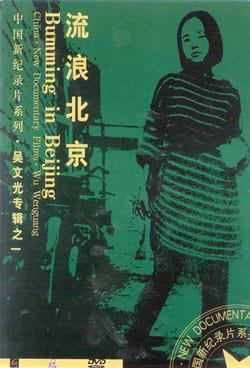
Bumming in Beijing |
|
Wu
Wenguang had started his film at the beginning of
1989, focusing on five of his artist friends, all
illegal residents in Beijing who, in order to try
and fulfil their dreams, had refused a job in some
remote province after graduating from university. He
was trying to capture an authentic impression of the
dark reality of life in the post-Tian’anmen back
alleys of the capital. The film broke new ground in
its style as well as its subject : it was influenced
by the cinéma-vérité style used in a Japanese TV
serial famous at the time, and developed into a
personalized and subjective approach. It is shot in
long slow sequences, like reflecting on empty
spaces, with long moments of silence, recalling
classical painting where the void is the main
element. But these moments of silent reflection are
like the negative echo, the other face of the
Tian’anmen protests, the silence after the storm. It
is a rather gloomy reflection, without any positive
outcome. |
|
Wu
Wenguang was very close to the other filmmaker at
the start of the independent cinema movement, this
same Zhang Yuan who launched the break with
the studio system and whose third film was,
actually, a documentary of the same kind,
co-directed with another member of the new
documentary movement, Duan Jinchuan (段锦川):
“The Square” (《广场》).
It seems that the idea of the new documentary
movement was initiated at a private meeting in the
house Zhang Yuan had then in a hutong in Xidan
(which has since then been destroyed). But the term
itself appeared for the first time on the documents
presenting “The Square” at the 16th Hong
Kong International Film festival, in 1993.
Zhan
Yuan films ordinary, everyday life on the square :
children playing with kites, old people playing
frisbee, people |
|
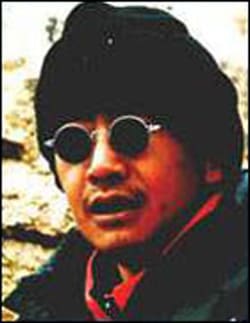
Duan Jinchuan |
passing by,
bicycling, others visiting, everything is quiet, peaceful.
But then, there are the policemen and soldiers, revealing
the omnipresent control of the State. And at the end of the
film, salves of cannon are fired, for some visiting foreign
statesman, and suddenly there is a flash of anxiety, tension
flaring on everybody’s face…
The film was
made right when Zhang Yuan had been blacklisted and
forbidden to film in China. He did it pretending to be
working for CCTV. He captures every reaction, without
dialogues nor music.
Duan Jinchuan,
for his part, was influenced by Wu Wenguang whom he met in
1990 while he was shooting “The Last Dreamers”. Both of
them, in turn, were influenced by other documentary
filmmakers’ works they saw in 1993 at the Yamagata Film
festival, where Wu Wenguang was awarded the Ogawa Shinsuke
prize for his documentary “When I Was a Red Guard” (《我的红卫兵时代》).
They were particularly awed by Frederick Wiseman and Bob
Connolly.
|
Wang Xiaoshuai
(王小帅)
too was part of the early days of this new
documentary movement. He had been sent to the Fujian
studio, in 1988, but managed to find enough money,
about 10 000 $, to shoot his first film, in 1993 : a
fiction film, but focusing on the life of two young
painters who were playing their own part. In
English, it is called “The days”, but the Chinese
title (《冬春的日子》)
means ‘the days of Dong and Chun’. The man was in
fact the now famous painter Liu Xiaodong (刘小东),
who at the time led the same marginal life as Wu
Wenguang’s friends.
The
film was immediately put on the black list, but this
kind of subject became commonplace. It was still the
subject of the first full-length documentary made by
Huang Weikai (黃偉凱)
in 2005 : “Floating” (《飘》),
on the wanderings of a street musician. |
|

The Days |
In the second
half of 1995, however, the independent filmmakers turned
again to fiction. But in doing so, they incurred the wrath
of the authorities.
3. The turning
point of 1996
a) New
restrictions
|
Then,
in 1996, he made
« East Palace, West Palace »
(《东宫西宫》),
the first film in China overtly on the subject of
homosexuality, subtly using the theme as a symbol of
the opposition between official and underground,
between centre and margin, and reverting to the old
imagery and symbolism of Chinese traditional opera.
This was enough to have problems.
In
addition, however,
Zhang Yuan managed to get his
film out of China for post-production in France. In
1997, it was then part of the official selection of
the 50th Cannes film festival, section
“Un certain regard”, and was widely publicized.
When Zhang Yuan came back to China afterwards, he
was deprived of his passport and the Chinese
authorities had passed drastic measures to make sure
this unfortunate state of event would not happen
again in the future - which heralded a period of
tightened shooting conditions. |
|
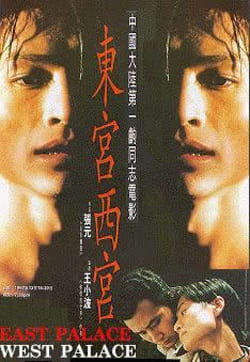
East Palace, West
Palace |
The 1st
of July 1996, the SARFT (State Administration for Radio,
Film and Television) issued a new regulation in 64 points
which strictly forbade the making of any film outside the
state studios ; in addition, no film could be produced,
distributed or imported without prior agreement of the
censorship authorities. Of course, as many Chinese laws and
regulations, it is a masterpiece of ambiguity, ideal to
justify the interdiction of any film whatsoever : it starts
with six good reasons to ban a film (if it constitutes a
danger for the State, defames it, reveals State secrets,
encourages pornography, superstition or violence), but then
a seventh point adds that it can also be banned “for any
other content forbidden by the legislation.”
A double
movement immediately followed – the one towards continuing
independence, the other back to the studio system - but both
with dire consequences.
b)
Movement back to the studios
This new
1996 regulation started a movement back to the studio
system, since it was in theory now impossible to make a film
outside a studio. But it is also the beginning of very hard
times for those who decided to reintegrate the system : the
art of compromise became a must, a quite frustrating art of
compromise. Here again the cases of Zhang Yuan and
Wang Xiaoshuai are
emblematic.
1. Zhang
Yuan
|
In
1999, Zhang Yuan makes a film in the Xi’an studio
which marks his return to the State system ; it is
his first film to have been released in China :
“Seventeen years” (《过年回家》).
The story takes place in Tianjin ; a young girl who
has just spent seventeen years in prison for killing
her half sister is granted permission to go back to
her family for the New Year ; but, at the moment of
leaving, nobody comes to collect her. A young female
prison guard then offers to accompany her back home.
But, when they arrive, they discover the old house
has been torn down and her parents have moved
somewhere else…
It took
Zhang Yuan a whole year to get his script approved,
but he did, and he even got the authorization to
film within a prison, which actually was the main
reason why he so much wanted to have his film
approved. It was the first time a
|
|

Seventeen Years |
camera entered
a Chinese prison. The film was released in December 1999,
and it was a big success.
2. Wang
Xiaoshuai
The other
interesting example of early attempts to play by the rules
is that of
Wang Xiaoshuai, who was one
the first to decide to do so. But it was not such a success
story.
|
Way back in 1994, he had conceived a
project which was supported by
Tian
Zhuanzhuang (田壮壮).
It was originally called “The Vietnamese Girl”, but
the script was refused by the censorship bureau. It
took three years of negociating, arguing and
bickering, even the title had to be changed. Finally
the film was authorized, under the Chinese title
“The porter and the girl” (《扁担·姑娘》)
- translated
“So Close to
Paradise”. It was produced by Han Sanping and the
Beijing studio.
But
the finished product had hardly anything to do with
the initial project. It has kept something of the
original film noir atmosphere and style, with a
wonderful work on colours, watered blues slashed by
sudden outbursts of light and flashes of red, but it
is so diluted it has lost all significance. Censors
have changed the focus, from style to emotion, in a
very ordinary Chinese fashion, and the script itself
is at times incoherent, making it hard to follow the
story. |
|
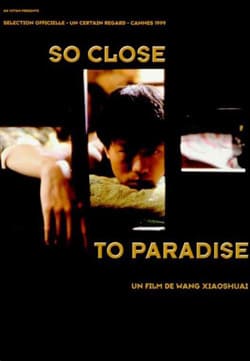
So Close to Paradise |
What is
worse is that accepting the censors’ requirements did not
even help the film get a good distribution, since it was
still considered with suspicion, even hostility, by the
authorities, for its dark atmosphere and pessimistic vision
of urban reality. Production started in 1994, but it was not
distributed in China before autumn 1998, and still with
limited diffusion. It was shown in Cannes in May 1999, in
the section “Un certain regard”, and was granted the Tiger
award of best film at the 2000 Rotterdam film festival, but
it remains a film of compromise.
It had been
supported by Wang Xiaoshuai’s friends in the Beijing film
studio who had lost a lot of money with it. So Wang
Xiaoshuai then made a comedy, hoping they would thus recoup
at least part of their losses. But the film was shot in
nightmarish conditions, and resulted in still worse losses.
So, for his
next film, Wang Xiaoshuai did not bother to pass censorship,
with the result that the film,
“Beijing Bicycle” (《十七岁的单车》),
was banned, in 2001. He had gone full circle.
c) Continuing
independence from the studios
The
frustrating limitations of working within the system were
enough to convince many independent filmmakers to remain
independent, in spite of the difficulties. But, at that very
moment, fortunate circumstances made it easier to film
outside the studios.
The
so-called ‘digital revolution’ changed the rules of
the game. Not only was it now possible to have light
equipment, with the possibility of editing the film on a
personal computer, it was also perfectly adapted to the
mainly urban subjects filmed : it permitted a free and
personal style, a vivid rendering of day to day, ordinary
life close to the characters depicted. And it was cheap.
1.
Documentaries
|
Two
documentaries made in 1999 can be considered as the
turning point of the digital era in China, which at
the time coincided with the development of
independent cinema : “Old Men” (《老头》)
by Yang Tianyi (杨天乙)
, and “Beijing Cotton Fluffing Artisan” (《北京弹匠》)
by Zhu Chuanming (朱传明).
Yang
Tianyi
is a typical case of this new generation of
filmmakers who emerged in the aftermath of 1996. She
was a dancer, then, in 1992, entered the PLA Art
Academy to become an actress, and actually played a
part in “Platform” (《站台》)
by Jia Zhangke. In her last year as a student in the
Academy, as she came back home, everyday, she saw a
group of old people who sat in front of the
apartment building where she lived ; she eventually
bought a small digital camera and filmed them for
two years, following their regular coming and going,
and registering their conversations.
|
|
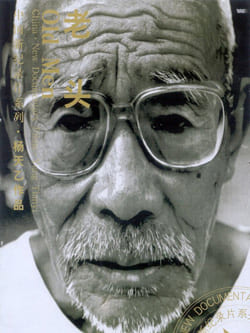
Old men |
Zhu Chuanming’s
case is slightly different as he worked first in a
petrochemical factory at the end of his studies, before
being admitted into the Beijing Film Academy to study
photography. It is while he was wandering in Beijing,
looking for subjects for photos, that he met a young migrant
worker, who recycled the cotton of old cushions and quilts
in a derelict hut along a main road. After a while, he
decided to film him, using an ordinary family-type camcorder
to do it ; the image is not the best, but the film is quite
exceptional, with a rare depth of
human and emotional feelings.
|
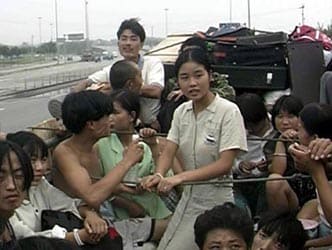
Jiang Hu |
|
DV was also instrumental in enabling older
filmmakers to renew their style, like Wu Wenguang
using a Betacam SP camera to make “Jiang Hu, a Life
on the Road” (《江湖》),
that same year 1999. But the two previous cases are
a kind of model for everything that was to develop
in the following years in the field of independent
documentary, leading to such masterpieces as
Wang Bing (王兵)’s
“West of the Tracks” (《铁西区》)
in 2003,
Zhao Liang (赵亮)’s
“Petition” (《上访》)
five years later, or
Xu Xin (徐辛)’s
“Karamay” (《克拉玛依》)
in 2010 : all |
works conceived and filmed over long periods of time, in a
symbiotic relationship between the filmmaker and his
subject.
However, this
development was not restricted to documentary ; or rather
this documentary style extended to fiction, and, at the same
time, the whole movement took a different spirit, another
face and renewed energy. It is often considered as a
second phase of the independent film movement.
2. Fiction
The
initiator of this change in the late 1990’s was of course
Jia Zhangke (贾樟柯)
whose “Xiao Wu” (《小武》)
in 1997 and “Platform” (《站台》)
in 2000 launched this new phase. Jia Zhangke and his friends
of the Beijing Film Academy Young Experimental Workshop were
born in the early 1970’s, raised in the era of reform, had a
strong distaste for the kind of filmmaking taught at the
Academy and a burning desire to make their own voices heard.
The big
difference was that Jia Zhangke came from an ordinary
lower-middle family, in a small town in Shanxi. He had to do
odd jobs to earn a living as a student, painting
advertisement billboards and putting up shop signs in
Taiyuan, Shanxi capital. When at the Beijing Film Academy,
he supported himself by writing TV episodes as a ghost
writer. He therefore wanted to reclaim cinema as means of
communication for the ordinary citizen, the one caught in
the midst of urbanization and economic turmoil. Beijing
Bastards were angry artists, Xiao Wu is a poor pickpocket in
the backwater of modernization.
Jia Zhangke
eagerly took advantage of the digital revolution, which was
also a cinematic democratization. He started with his short
documentary “In Public” (《公共场所》),
in 2001, because it was made for the festival of Jeonju in
South Korea, which makes it one of its requirements. But it
influenced the making of the film, giving him a lot of
freedom of movement. Then, partly since his next film,
“Unknown Pleasures” (《任逍遥》),
had serious budgetary problems, he also shot it in digital,
very quickly, in nineteen days.
But this
film marks the high tide of the digital movement, Jia
Zhangke explained he found the technique has limitations and
he had to cut a number of scenes because the quality was not
good enough. It is also the last film he made outside the
studio system. 2002 is also a turning point.
4. The
other turning point of 2002
The
restrictions and controls exerted on cinema after 1996 had
had dire consequences. The number of films made annually
fell from a yearly average of approximately 150 in the
mid-1990’s to 88 in 1997 and even 82 in 1998. Still worse,
of the 88 films produced in 1997, only 44 obtained approval
for release from the censorship bureau. Audience numbers
plummeted. But Titanic made 4 million US$ in Beijing movie
theatres alone in 1997.
a)
Restructuring and drive for profit
The threat
represented by imported films, mainly American, coupled with
the poor results of domestic films, were enough to
precipitate a dramatic reconstruction of the State-owned
film industry. Starting in 1999, some State-owned studios
began to be restructured along the lines of joint-venture
companies with private investments, or incorporated into
large entertainment-related enterprises. The movement
started with the Beijing Film Studio ; the model was in turn
borrowed by the Shanghai film studio, then those of
Changchun and Xi’an. Then, as the three sectors of
production, distribution and exhibition were opened to
private companies, local and international investors got
involved in the moviemaking industry. Furthermore, in 2003,
limitations on co-production were lifted ; non-State
production companies could apply for production licenses.
As a result,
the involvement of foreign capital in all sectors of the
film industry undermined the very nature of Chinese cinema.
Long considered a pedagogical tool used to support Party
policy, it had increasingly to respond to the demands of
domestic and foreign investors for profits. As a result, in
the early 2000’s, profit making, and therefore
commercialization, became a major preoccupation of the
Chinese film industry.
b) Relaxation
of censorship
This
preoccupation induced a relaxation of censorship procedures.
In September 2003, the SARFT issued new regulations for
script approval : a draft script had to be approved prior to
shooting, but, after the film was completed, it could be
submitted to local or provincial censorship committees. Out
of 214 films completed in 2004, only one HK movie was
rejected, because of its depiction of violence, and in 2005,
251 films passed censorship. Most of the investment in these
films were from non-State companies.
c) Resurfacing
of many independent filmmakers
As a result of
this loosened censorship control, announced in a solemn
meeting in December 2003, many independent filmmakers had
their films approved for release. Jia Zhangke was one of
them. He has repeatedly said in interviews that the reason
for his surfacing from the underground was only the relaxed
environment of censorship :
“Originally…
the censorship apparatus was, to a large degree, restricting
our freedom of choice. But now, it looks like we’ll have the
chance to express ourselves freely, and that’s why I’m
willing to give it a try.” (2)
He had prepared
himself for lengthy requests for revisions, but it was not
even the case : he had to review the language used in a few
lines of dialogue, ant that was it.
Others also
joined mainstream cinema at the same time and for the same
reason.
Wang Xiaoshuai had the ban
on
“Beijing Bicycle” (《十七岁的单车》)
lifted ; then his 2005 film,
“Shanghai Dreams” (《青红》),
was approved by the censors, and even submitted to the
Cannes film festival as China’s official submission. Similar
cases occurred for Lou Ye (娄烨)
-
“Purple Butterfly” (《紫蝴蝶》)
was
allowed to show in China, which might explain the flaws and
discrepancies in the script, but he has since then reverted
to a defiant underground, while others like Jiang Wen (姜文)
have taken the commercial mainstream option.
II.
Double Dependence : Present Challenges
The problem
nowadays is that this relaxed atmosphere has not survived
the Olympic Games, and the so-called independent cinema has
now fallen into a double dependency : worst censorship ever
and obsession for the market. In other words, economic
constraints are now added to political or ideological
restrictions, the worst of situations.
But independent
cinema still survives at the margins, and remains, in spite
of everything, a creative sector full of drive and dynamism.
1. The
challenges
a) The
challenge of censors
Nowadays,
censorship has become obnoxious even for the best mainstream
filmmakers. Two recent anecdotes reveal the underlying
tension among the profession.
|
1. In
August 2011, a theatre play was a tremendous hit in
Beijing. It was a comedy, called “The sorrows of
comedy” (《喜剧的忧伤》),
and the main part was played by the popular actor
Chen Daoming (陈道明),
but this does not entirely explain the reason for
its incredible success. It is in fact a satire of
the absurdity of censorship now prevailing in China.
The
main character is a writer of comedies who wants to
have his latest script approved. The play takes
place in 1940, |
|

Chen Daoming en
censeur borgne
dans « The Sorrows of
Comedy » |
and the censor
is a general who recently came back from the front, where he
lost an eye. He begins saying that people don’t want to
laugh in time of war, then, in the following week, starts a
thorough analysis of the script, asking for the most
delirious and hilarious revisions.
This is the
funny part, but the sad one came later : after the premiere,
there was a cocktail party attended by the best and the
brightest of Chinese theatre and cinema. Among the
celebrities attending was
Feng Xiaogang : he was reported to have been so
shocked by the play that his hands were shaking and he
dropped his glass which crashed on the floor. His wife, the
actress Xu Fan (徐帆),
collapsed on her knees to collect the pieces and burst down
in tears. She later wrote on her micro-blog : “The comedy
has turned into a tragedy.”
2. Then, in late August, the same
Feng Xiaogang burst out during a formal address
at an official conference about the so-called “Cultural
Reform”. His words were quoted in an article of the People’s
Daily, at the end of the month :
“The
pressure of censorship on filmmakers and creators has been
reinforced. The
SARFT makes
dubious interpretations of everything, and passes judgments
on questions of principle. The required revisions have
become ridiculous…. This stupid system is hampering
cinematographic creation and thus damaging it.”
He added :
“A film is
defined as “positive” or “negative”, this is the only
criterion of judgment used by the censors, but, at the same
time, artists are required to create works able to survive
in the future, as if the great classical works of the past
could be judged according to their being “positive” or
“negative”. The result is that everybody now prefers to
remain on the safe side, and avoid contemporary subjects
which might be deemed “negative”.” (3)
If this is true
of somebody like
Feng Xiaogang, one can
easily imagine what it can be for young filmmakers trying to
create something new and original.
But the most
tragic is that filmmakers are now much more pressured by the
drive for commercialization, the obsession with the market.
Having a film approved is not the end of the story. And
that’s where independence becomes much of an illusion.
b) The pressure
of the market
The drive for
the market is not in itself something new ; it dates back to
the 1980’s, at a time when the authorities tried to
reconstruct a system which had become obsolete and
financially bankrupt. Subsidies were curbed, and studios
given increased autonomy. At the same time, there was a
rediscovery of the audience, its tastes and aspirations,
better known thanks to opinion and popularity polls, in
particular those of the journal “Popular Cinema” (大众电影).
This led to a
change in the tripartite balance of power defined by Paul
Clark, between the Party, the filmmakers and the public (4),
and had positive results : the policy of “opening up” in the
field of cinema also meant stylistic experimentation, a
complete renewal of styles and themes.
But the
autonomy granted to the studios also gradually led to more
dependence on financial results, and therefore on the box
office, to be able to optimize returns on investments. It
became an obsession after the financial and restructuring
reforms at the beginning of the millennium.
In the early
2000’s, the film authorities formally acknowledged cinema as
an industry which, from then on, had to operate first and
foremost on the basis of the market and aim at
profit-making. As is often the case, the change appears in
the very wording of the official documents : they had
previously referred to cinema as a “service”, an undertaking
with serious political and pedagogical functions (shiyè
事业);
now, the new documents issued by the SARFT began using the
word “industry” (chǎnyè
产业).
The official
discourse then continuously emphasized the need to
industrialize Chinese cinema especially in order to make it
competitive on the international markets, a
new policy that
was developed in the wake of the 16th National
Congress (5). In that context, it was of course the
Hollywood model which was in everybody’s minds, for State as
well as private film productions. But the commercialization
of cinema also had its domestic component, that is the
targeting of domestic audiences to make them into a
profitable market.
The latest
development was brought about by “Avatar” when it was
released on the mainland in January 2010. Titanic had been a
shock, Avatar was almost a trauma. The Chinese film
authorities now have only one goal : master the 3D technique
and beat the Americans.
c) The
marginalization of small budget and art films
The result is a
resolute expansion of chains of big movie theatres catering
to a mainly urban, white-collar and trendy audience which
considers cinema as a fashionable entertainment. It is also
an expensive one, and more and more so as movie theatres are
developed as a form of very lucrative investment.
Nowadays, less
than 20 % of films made and approved are released in
mainland China, and about half can boast to have a good
distribution, so that independence has become more of an
illusion, and a marginal question anyway. Mainstream or
independent, filmmakers are all in the same situation. If
they don’t produce films promising to be big hits, they have
no chance of being released. Not long ago, it was censorship
their worst problem, and the reason for their choice of
independence, with the consequence that they were dependent
on international festival circuits for international
recognition. But they were disconnected from the audience in
China.
Today, market
forces are much more insidious than censorship, but the
result is still the same : independent filmmakers are
disconnected from their domestic audience, and the solution
does not seem easy to fathom. They depend on small venues,
film bars, minjian film clubs, university backyards,
but more and more on domestic film festivals. Those are a
new interesting phenomenon which is tolerated by the
authorities provided they do not make too much
advertisement, and keep a low profile. One of the latest
creations, the
Beijing
First Film Festival, founded and animated
by Wen Wu (文武),
seems to
be gathering momentum, and gradually building an audience ;
it has even started a cooperation with the French festival
Angers Premiers Plans.
Another
promising development could be the internet, with the
diffusion of VOD on dedicated sites like tudou or
youku. But it is all very fragile, since dependent on
the vagaries of politics and on the bigger problem of the
definition of a public space.
However, the
spirit of independence still lingers, and, while mainstream
cinema hardly departs from historical blockbusters or
comedies, in a cautious move to limit risks and optimize BO
returns, the few remaining so-called independent filmmakers
are creating interesting new forms and styles.
2. A continuous
creative drive
Some filmmakers
have opted for an image of artiste maudit, defiantly
pursuing works produced abroad and tailored for
international audiences, but totally cut from the mainland.
This is, for instance, the case of Lou Ye, but his talent
seems to be waning.
More
interesting is the multifaceted stylistic and aesthetic
research pursued by various filmmakers in China, engaged in
a rhizome-like diversification of styles.
a) Lines of
flight
Documentaries
certainly are the most numerous works representative of the
Chinese independent movement. Many documentary filmmakers
continue their socio-political critique (Du
Haibin,
Wang Bing,
Xu Xin…)
: those are documentaries treated like works of fiction,
with a strong narrative line emphasized through careful
construction and editing.
|
But
there is also a strong trend towards focussing on
the private, intimate and day to day life (Liu
Jiayin (刘伽茵)’s
“Oxhide 1/II”
《牛皮贰I/II》),
or even spiritual experience (Ma Li’s
“Mirror of Emptiness”
《无镜》).
There are so many documentaries being made right now
on all aspects of Chinese life, society and even
scenery that it will constitute a formidable archive
for the future, if they are well preserved, which is
a point to keep in mind.
The
general picture is one of swarming talents of
various origins, especially, now, on the margins.
There is a whole array of photographs and painters
whose works have a distinct aesthetic quality, and a
cross-breeding with the artistic scene. They are
part of a strong movement of experimental video,
with diversifications in the field of animation.
|
|
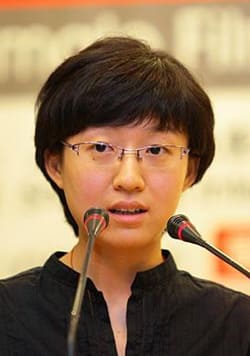
Liu Jiayin |
b) Lines of convergence
It seems there are thus innumerable lines of flight, an
incredible creative richness which barely surfaces but is
the most pregnant of Chinese cinema today, but which also
hides lines of convergence since there is a kind of group
phenomenon, around a school or around a person.
|
For instance, the Central Academy of Drama, in
Beijing (中央戏剧学院),
may appear as an alternative to the Beijing Film
Academy. From there comes a group of original
filmmakers like
Cai Shangcun (蔡尚君),
Diao Yinan (刁亦男)
or
Liu Fendou (刘奋斗),
who worked for a while together, at the end of the
1990’s, as scriptwriters for
Zhang Yang (张扬)
and Shi Runjiu (施润玖)
; Liu Fendou then started his own production company
and produced “Spring Subway” (《开往春天的地铁》)
by Zhang Yibai (张一白)
en 2002. It was then the best years for independent
cinema.
Private
groups have also emerged over time, many of them
created by the artists themselves. One example is
Zhang Xianmin (张献民)
and his Beijing Indie Workshop (影弟工作室)
founded in 2005 to promote Chinese
independent cinema and which has lately produced
“Old
Dog” (《老狗》),
the last film |
|

Zhang Xianming |
by
Pema Tseden
(万玛才旦).
Zhang Xianming is also the founding father of the Chinese
Independent Film Festival (CIFF) which is nowadays the most
important and influential venue for independent filmmakers.
This is
certainly one of the strengths of the movement : filmmakers
are not isolated, and they have a common sense of mission,
as Ling Zifeng (凌子风)
‘s son Ling Fei said in 2009 :
“At the
beginning, underground or independent films claimed an
engagement, a personal language. The filmmaker decided to
choose a subject the official cinema would never have
considered. So, there have been good films, but there have
also been films whose only specificity was in their subject,
irrespective of the way it was treated. Today, … if a
filmmaker decides to stay independent, it is because he
wants to concentrate on the artistic quality of his film,
and work independently of market trends.” (6)
But, in spite
of this creative impetus, there are signs of discouragement,
a perceptible mood of disillusionment which may be the most
worrying today. At their best, those filmmakers keep the
hope of being eventually able to work within the system and
having their films released domestically. But it seems to be
a long road to get there.
Conclusion :
2012, beyond independence, or independence on the margins…
The very idea
of independent cinema has been from the very start fraught
with illusions. Nowadays, independence in the realm of
filmmaking has lost much of the relevance it might have had
at one point in time. But since there is still a spirit of
independence as a creative force pushing forward unabated,
in this sense there is still an independent cinema in China.
Its main problem is now to get known, inside China.
The prevailing
model, in this respect, is Jia Zhangke. On can argue that he
is
trying to bridge the gap between independent and mainstream
cinema, trying to bring up a new narrative, new aesthetics
to the Chinese mainstream cinema. He is defining an
alternative way, and, in this sense, he may represent the
best hope for independent filmmakers by the way he manages
to have his voice heard in official circles, but without
compromising on his aesthetic principles, intent on
maintaining a relatively high freedom of artistic creation.
But he
has been rather absent lately and we are still waiting for
his next film, “The Age of Tattoo”, which has been in the
making for quite a while now.
However, even
in his case, the fundamental point remains the access to the
audience, and the screening opportunities. Jia Zhangke’s own
experience shows that even an official release is not the
end of the problem. When “The World” (《世界》)
was released, it hardly made 100 000 euros, and soon
disappeared from the few screens where it had been shown.
When “Still Life” (《三峡好人》)
was released, on the 14th of December 2006, it
was the same day as
Zhang Yimou’s “Curse of the
Golden Flower” (《满城尽带黄金甲》).
“Still Life” had just been awarded the Golden Lion in
Venice, but it was released at odd hours, at 9 in the
morning or 1 in the afternoon in many places, how can a film
compete against an official blockbuster in such conditions,
without even speaking of the difference in promotion budgets
?
In addition,
tickets price in China are today much too expensive :
cinemagoers prefer to go and see the big dapian which
makes the headlines or the latest comedy hit which seem much
more rewarding in view of the money spent. If cinema has
become an industry, for the audience, it has become pure,
but expensive, entertainment.
Raising public
awareness, forming the tastes of the public are nowadays the
most difficult challenges for Chinese independent cinema.
This was clearly indicated in a recent initiative made at
the last meeting of the Association of Chinese filmmakers,
in 2011. The Association had created prices in 2005 which
have been granted only twice since then. It seems they now
want to actively promote young filmmakers and small budget
films ; interestingly, there is no mention of independent
cinema per se, which is revealing, but the initiative is led
by respected figures like
Tian Zhuangzhuang (田壮壮)
and
Xie
Fei (谢飞).
The latter announced that their main objective was to
negotiate with movie managers to give small budget films
more visibility, one of the points to discuss being a
decrease in tickets prices in specific cases (7).
But the main
problem arises from policies which are insisting on
considering cinema as an industry, with the only purpose of
making profits. It is indeed nowadays restricted neither to
China nor to cinema, but it has taken unique proportions in
China. Since 2003, the SARFT has been collecting 5% of box
office revenues, to finance a fund dedicated to the
development of the “film industry”. Even big production
companies are affected ; Huayi, for instance, had to pay
SARFT half of its 2011 profits. And this goes to finance
such films as Wuxia or the latest 3D blockbusters.
We are
witnessing a return to quantitative practices that are
redolent of past times, we also feel a terrible sense of
urgency, in official circles, of catching up, akin in spirit
to the Great Leap Forward, with cinema replacing steel, and
Hollywood Britain. But the combination of tightened controls
and the urge to “industrialize”, make profit and compete on
international markets has resulted in 2012 in a dearth of
good Chinese films. The exceptional growth figures of the
mainland box office are due for the main part to the
American blockbusters’ continued success.
In this dire
situation, independent cinema is fighting for survival. A
double movement is taking shape : many independent fiction
filmmakers are going back to the mainstream in the hope of
getting more visibility in their country, and to try and get
some financial return on their work ; the big names have
left the boat. At the same time, there is a frenzy of
documentary filmmaking, mainly because there are so many
attractive subjects and shooting with light digital cameras
is easy and cheap. The result is not necessarily
satisfactory in qualitative terms.
There remains a
small number of very good documentary filmmakers who will
continue to work independently because they need to retain
their freedom of expression. An interesting development now
seems to be the
experimental cinema
which has appeared on the margins, but with a different
model altogether : initially backed by the big institutions
like the Beijing Film Academy and the
Central Academy of Drama, it is now evolving as an artistic
movement which might well provide in the years to come the
best and the brightest at the brink of independent cinema.
Notes
(1) The
interviews were edited by Ouyang Jianghe (欧阳江河),
a poet and
prominent critic of music, art, and literature ; as he was a
key figure of the literary magazine Jintian,
the interviews were
published at the same time in a special issue of the
magazine and in Hong Kong by
Oxford University Press, in 2007. This is a common
reference.
(2) Valerie
Jaffee, « An interview with Jia Zhangke », Senses of Cinema,
June 2004.
(3) Voir :
http://www.chinesemovies.com.fr/actualites_2.htm
(4) Paul Clark,
Chinese Cinema : Culture and Politics since 1949, 2-3.
(5)
In January
2003, the vice-director of the Film Bureau of the SARFT made
a speech at the National Conference of Film Production,
where she proposed guidelines for 2003. Her speech was
entitled : “For a full implementation of the spirit of the
16th National Congress to promote and foster the
reform, development and renovation of the film industry” (全面贯彻十六大精神加快推进电影产业的改革发展创新)
:
http://www.law-lib.com/fzdt/newshtml/22/20051111212001.htm
(6) Interview by
Luisa Prudentino, Monde Chinois, Regards sur les cinémas
chinois, n° 17, p. 82.
(7) Voir
:
http://www.chinesemovies.com.fr/actualites_35.htm
Selected
bibliography
- Berry, Chris.
Postsocialist Cinema in Post-Mao China : the Cultural
Revolution after the Cultural Revolution, Routledge, 2004.
- Berry,
Michael. Speaking in Images : Interviews with Contemporary
Chinese Filmmakers, Columbia University Press, 2005.
- Clark, Paul.
Chinese Cinema : Culture and Politics since 1949, Cambridge
University Press, 1987.
- McGrath,
Jason. Postsocialist Modernity : Chinese Cinema, Literature
and Criticism in the Market Age, Stanford University Press,
2008.
-
Pickowicz,
Paul/Zhang, Yingjin (eds). From Underground to Independent :
Alternative Film Culture in Contemporary China, Lanham,
Rowman & Littlefield, 2006.
- Zhang, Rui.
The Cinema of Feng Xiaogang : Commercialization and
Censorship in Chinese Cinema after 1989, Hong Kong
University Press, 2008.
- Zhang, Zhen (ed).
The Urban Generation : Chinese Cinema and Society at the
Turn of the 21st Century, Duke University Press,
2007.
Monde chinois,
Regards sur le cinéma chinois, Choiseul Editions, n° 17,
printemps 2009.
China
Perspectives, Independent Chinese Cinema : Filming in the
“Space of the People”, n° 2010/1
SARFT official
website :
http://www.sarft.gov.cn/
|
|